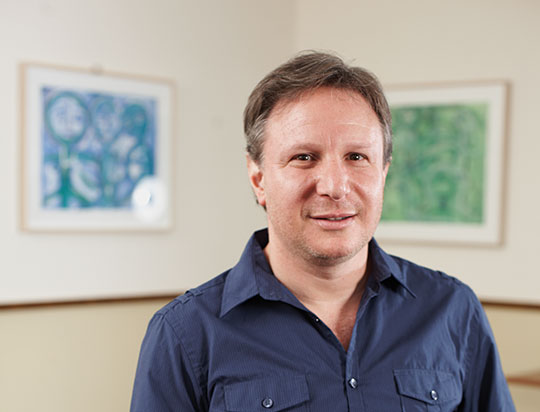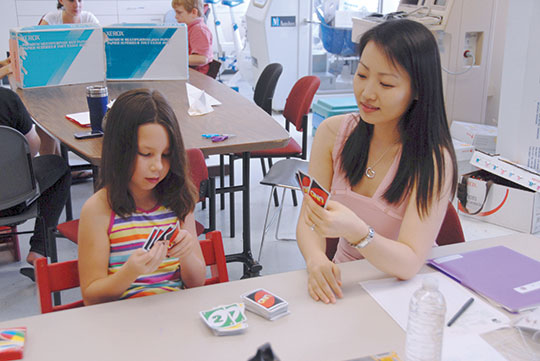The Sound of Two Hands Clapping
TC's Andrew Gordon has developed a bimanual therapy for cerebral palsy that could change the field
TC’s Andrew Gordon has developed a bimanual therapy for cerebral palsy that could change the field
On the tenth floor of Thorndike Hall, a group of children are wiping down their tables after a spending an hour making sushi.
“Use two hands!” an adult supervisor calls out.
That frequent refrain of nervous parents everywhere has a very different connotation here at a summer camp operated by TC’s Center for Cerebral Palsy Research.
Kids who attend the camp each July have hemiplegia, a severe weakness in the limbs that results in very low dexterity on the affected side of the body. To help correct that imbalance, the camp employs a technique called Hand-Arm Bimanual Intensive Therapy (HABIT), developed by the Center’s director, Andrew Gordon, TC Professor of Movement Science. The technique requires the children to make equal use of their weak-side limbs, whether in making sushi or lifting weights.
Gordon, a clean-cut man with a reassuring manner, became interested in kids with cerebral palsy 20 years ago after being told, as a graduate student, not to focus on rehab.
“The general consensus was that this kind of impairment didn’t get better, but I just didn’t believe it,” he says. “I had worked with these kids and seen their hand movement improve after just an hour in the lab.”
Some years ago, Gordon began exploring the therapeutic constraint of patients’ sound limbs—a technique that improved weak-side mobility but did not improve coordination difficulties of the two hands together. He subsequently developed the bimanual HABIT approach—in part out of a desire to help kids and their parents meet immediate goals such as zipping a jacket, dressing a doll or using a computer.
This past July, Gordon and his team set out to measure improvement in kids’ mobility after three and a half weeks of daily bimanual therapy. Through transcranial magnetic stimulation (TMS) conducted before and after the July session by Gordon and Kathleen Friel, Professor of Clinical Neurobiology at Columbia Medical School, they also hoped to identify any “brain plasticity”—creation of new neural pathways—that occurred as a result of the rehabilitation. Understanding brain mechanisms that underlie changes in dexterity could clear the way for use of direct stimulation of the brain paired with manual therapy as a new form of treatment in this population.
“I’m confident that’s going to happen,” says Gordon.
Currently, though, Gordon and his team are focused on helping kids make incremental improvements in dexterity. Each morning last July, the eight campers, hailing from as far away as Michigan, Mississippi and Virginia, separated into groups to work with their interventionists, most of whom were TC graduate students and undergraduate volunteers from CUNY and other schools interested in physical therapy and neurology.
The activities were physically demanding, but also fun: Lincoln Logs, Chutes and Ladders, and Battleship; competitions to pull the most strips of masking tape off a wall, with stickers for rewards; playing marbles; word games on the computer; and—most coveted of all—Nintendo Wii.
Throughout the day, Gordon’s team missed no opportunity to gently prod campers to do more. The results were striking. After two weeks, a seven-year-old boy named Jake could pick up a small bead with his index finger and thumb. On the first day, he had barely been able to open his balled fist enough to extend his fingers.
In part, that gain was a result of Jake’s daily strength-building sessions with Eugene Rameckers, a physical therapist from the Netherlands who has opened his own camp there partly modeled on Gordon’s.
One afternoon, Jake and Alison Schonberger, a Columbia undergraduate, joined Rameckers in a small office, where Jake poured water from one pitcher to another. Rameckers, crouching in front of him, urged him to “keep it horizontal” and “keep your wrist straight.”
“I never got a tile wet before,” Jake said, a bit testily. A moment later he splashed water on Ramecker’s pants. Before anyone could say anything, Jake raised his eyebrows. “That’s not a tile,” he said.
By camp’s end, all the campers had markedly improved their hand function, averaging a nearly 40 percent increase in manual dexterity.
“That’s consistent with our earlier findings,” Gordon said. “It’s double what would naturally occur over many years of development, and we achieved it in just three weeks.”
Equally exciting, TMS thus far is showing brain plasticity associated with the improvements. If TMS can pinpoint precisely what kind of neural changes are occurring, the field may be poised for a major advance.
Thanks to their time at TC, Gordon’s campers may be among those applauding.
Published Friday, May. 20, 2011

